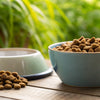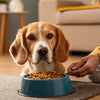Why Do Dogs Love Wet Food? Understanding Their Preferences
- Houndsy
Table of Contents
- Introduction
- Understanding the Appeal of Wet Food
- Medical Reasons for Wet Food Preference
- Non-Medical Reasons for Wet Food Preference
- Transitioning Back to Dry Food
- Quality of Food Matters
- Conclusion
- FAQs
Introduction
Imagine the scene: You’re preparing your dog’s dinner, and their tail is wagging excitedly. You scoop out some dry kibble, and to your surprise, your dog sniffs it, turns away, and moves to the cupboard where the wet food is stored. If this scenario sounds familiar, you're not alone. Studies show that over 60% of dog owners have pups who favor wet food over dry kibble. So, what’s going on here?
In this blog post, we’ll explore why dogs love wet food. We’ll delve into both medical and non-medical reasons behind this preference and discuss how to balance their diet for optimal health. You'll learn valuable tips to enhance your dog's feeding experience and ensure they receive the nutrition they need. By the end, you’ll have a deeper understanding of your furry friend's eating habits and how to improve their meal times.
Reflect on your own dog's feeding routine as we dive into the details. Are you making the most of their mealtime? Let's find out!
Understanding the Appeal of Wet Food
The Palatability Factor
One of the biggest draws of wet food is its taste. Wet dog food often contains higher fat content and an array of enticing flavors, appealing aromas, and richer textures that make it much more appetizing than dry kibble. Imagine your dog having a sensory experience with each meal, taking in the delightful smells and appealing moist textures. For pregnant or nursing mothers, as well as picky eaters or those with reduced appetites, the wet food can stimulate their desire to eat when they otherwise might not.
Nutritional Considerations
The nutritional makeup of wet food significantly contributes to its appeal. With a moisture content of about 75-80%, compared to the minimal 10% in dry food, wet options can help prevent urinary tract issues and promote overall hydration, especially for dogs that might not drink enough water. This is particularly crucial for dogs with specific health conditions, as proper hydration is fundamental to kidney health.
Age and Health Factors
As dogs age, their dietary preferences and needs change. Senior dogs, for instance, may develop sensitivity to harder kibble due to age-related dental issues or decreased chewing ability. Wet food can be easier to manage as it is typically softer, making mealtime less of a chore for older companions. With their taste buds changing and an altered ability to smell, the rich aromas of wet food can be particularly enticing.
Medical Reasons for Wet Food Preference
Dental Health Issues
If your dog has recently adopted a preference for wet food, examining their dental health is a wise first step. Pain from dental diseases, gum infections, or dental issues can deter dogs from chewing hard kibble. When observing such changes in habits, it’s crucial to consult a veterinarian. Addressing dental health can help restore your dog's interest in dry kibble and reassure you of their well-being.
Gastrointestinal Sensitivities
Certain medical conditions make digesting dry food challenging for some dogs. Dogs with gastritis, inflammatory bowel disease, or food allergies may gravitate toward wet food, as it generally contains easier-to-digest formulations. The higher moisture content found in wet food can also alleviate nausea and prevent upset stomachs, making these feeding options easier for sensitive pups.
Age-Related Changes
As dogs grow older, their appetites and food preferences may change as well. Senior dogs may find wet food more enticing and easier to eat because of its texture and enhanced flavor. Understanding these changes can help pet parents navigate nutritional needs, ensuring that their furry friends remain healthy and happy at every life stage.
Non-Medical Reasons for Wet Food Preference
Picky Eating Habits
Some dogs develop a penchant for wet food simply because they’ve tasted something better than what they typically eat. If you've rewarded your pet with wet food or table scraps from time to time, they may start to reject dry kibble in favor of those richer options. Acknowledging their picky eating habits can help you re-establish a healthier feeding regimen.
Boredom with Regular Dry Food
Dogs can become bored with repetitive meals just like us. If your dog has been munching on the same bag of dry food for months, they might lose interest. To combat this, consider rotating different dry food brands or flavors to keep mealtime fresh and engaging. Adding a spoonful of wet food can also help revitalize their interest.
Transitioning Back to Dry Food
If your dog has developed a preference for wet food, and you want to reintroduce dry kibble, here are some effective tips:
Gradual Introduction
Introduce dry food gradually by mixing small amounts into their wet food. A good starting ratio might be 75% wet food to 25% dry food for a few days before adjusting this balance incrementally. Gradually increasing the amount of dry kibble helps to minimize digestive upset, making the transition smoother.
Enhance Dry Food Appeal
To enhance the attractiveness of dry kibble, consider adding warm water or low-sodium broth to replace moisture, which can soften the texture and amplify its aroma. Healthy toppers, like pureed pumpkin or boiled chicken, can also transform less appealing kibble into a delightful meal.
Consistent Feeding Schedule
Establishing a routine can help your dog anticipate mealtime and build a sense of security. Limit the duration of meals to 15-20 minutes, removing uneaten food afterward to encourage them to eat when food is available. This method reinforces a consistent feeding routine that can help shift preferences back.
Quality of Food Matters
Choosing the Right Products
In pursuing your dog’s health, choosing high-quality food is essential. At Houndsy, we understand the intricacies of canine nutrition. Our Houndsy Kibble Dispenser—designed with both quality and aesthetics in mind—ensures that your dog's dry kibble remains fresh and properly portioned. With a 25-30 lbs storage capacity, a BPA-free liner, and an auto-locking mechanism, it’s a top choice for pet parents who value convenience and design.
For those looking to elevate their dog's feeding routine, explore our Houndsy Kibble Dispenser here.
Proper Storage
Properly storing your dog's dry food is crucial for retaining its freshness and flavor—keeping it in an airtight container in a cool, dry place will encourage your pet to eat with gusto.
Conclusion
Understanding why dogs lean toward wet food over dry kibble can significantly improve their health and overall well-being. By examining both medical and non-medical factors, we can better cater to our dogs’ dietary preferences while ensuring balanced nutrition.
If your furry friend shows a marked preference for wet food, don’t hesitate to implement strategies for transitioning back to dry food. Gradual introductions, enhancing the appeal of dry food, and maintaining a consistent feeding schedule can all contribute to a more balanced diet.
Quality food and proper storage also play pivotal roles in ensuring our dogs are healthy and happy. Always consult your veterinarian if you have lingering concerns regarding your dog's eating behavior, as they can provide tailored advice. Together, we can ensure our furry companions lead their happiest, healthiest lives!
FAQs
-
Why is my dog not eating his kibble but will eat wet dog food?
Dogs may prefer wet food due to its palatability, higher moisture content, or dental issues that make chewing dry kibble uncomfortable. -
How do I get my dog to eat dry dog food again?
To encourage your dog to eat dry food, gradually introduce it mixed with wet food, enhance its flavor with toppings, and establish a consistent feeding routine. -
Is it okay if my dog only eats wet dog food?
While it’s generally acceptable for dogs to eat wet food, it’s important to ensure they receive balanced nutrition. Consulting your veterinarian is advisable if you consider making wet food their primary diet. -
Why does my dog like wet food more than dry dog food?
Wet food is often more palatable due to its rich flavors and aromas, making it appealing to dogs, particularly those with dental issues or gastrointestinal sensitivities. -
Can switching from dry food to wet dog food harm my dog?
Switching from dry to wet food won't harm your dog if done gradually and thoughtfully. Nevertheless, it's essential to ensure they receive all necessary nutrients, so consulting a veterinarian for guidance is recommended.
Explore how the Houndsy Kibble Dispenser can enhance your dog’s feeding experience today! Visit us here.












